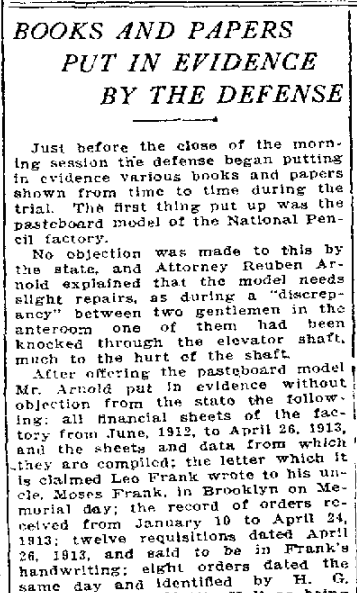Another in our series of new transcriptions of contemporary articles on the Leo Frank case.
Atlanta Constitution
August 19th, 1913
Just before the close of the morning session the defense began putting in evidence various books and papers shown from time to time during the trial. The first first thing put up was the pasteboard model of the National Pencil factory.
No objection was made lo this by the state, and Attorney Reuben Arnold explained that the model needs slight repairs, as during a “discrepancy” between two gentlemen in the anteroom one of them had been knocked through the elevator shaft.
After offering the pasteboard model Mr. Arnold put in evidence without objection from the state the following: all financial shoots of the factory from June, 1912, to April 26, 1913, and the sheets and data from which they are compiled; the letter which it is claimed Leo Frank wrote to his uncle Moses Frank, in Brooklyn on Memorial day; the record of orders received from January 10 to April 24, 1913; twelve requisitions dated April 26, 1913, and said to be In Frank’s handwriting; eight orders dated the same day and identified by H. G. Schiff and Miss Mattie Hall as being written In Frank’s handwriting; ten carbon-copy letters which Miss Hall swore Frank dictated to her on the morning of the day of the murder; page 195 of the cash book of the National Pencil company, dating from April 21 to 24; specimens of cabbage, submitted by Dr. H. T. Hancock; the four affidavits made by Jim Conley, on May 18, 24, 28 and 29 respectively; records of the various convictions against C. B, Dalton, a witness who swore to Frank’s alleged misconduct with women in his office.
Next the defense offered certified copies of indictments said to be pending now against Dalton in Walton county for selling liquor to one Bob Harris. Solicitor Dorsey got these ruled out, on the ground that an indictment does not necessarily mean anything.
The following documentary evidence was submitted by the defense at the close of the morning session and accepted by the court:
That part of Newt Lee’s testimony at the coroner’s inquest in which he describes Frank’s meeting with Gantt at the pencil factory.
That part of Harry Scott’s testimony at the inquest which states the accused man did not tell him anything of Gantt being intimate with Mary Phagan.
The reports of the Pinkerton detective agency pertaining to the first Interview with the accused man.
The proceedings under which Jim Conley was released from the Tower and transferred to police headquarters.
That part of Nowt Lee’s testimony at inquest relating to his discovery of the body.
That part of Lee’s testimony at inquest pertaining to Frank’s removal of time-clock slips.
Photographs of the Selig home, plans of the structure and block in which It Is situated, plans of the pencil factory and photographs of the building, twenty-five in all.
* * *
